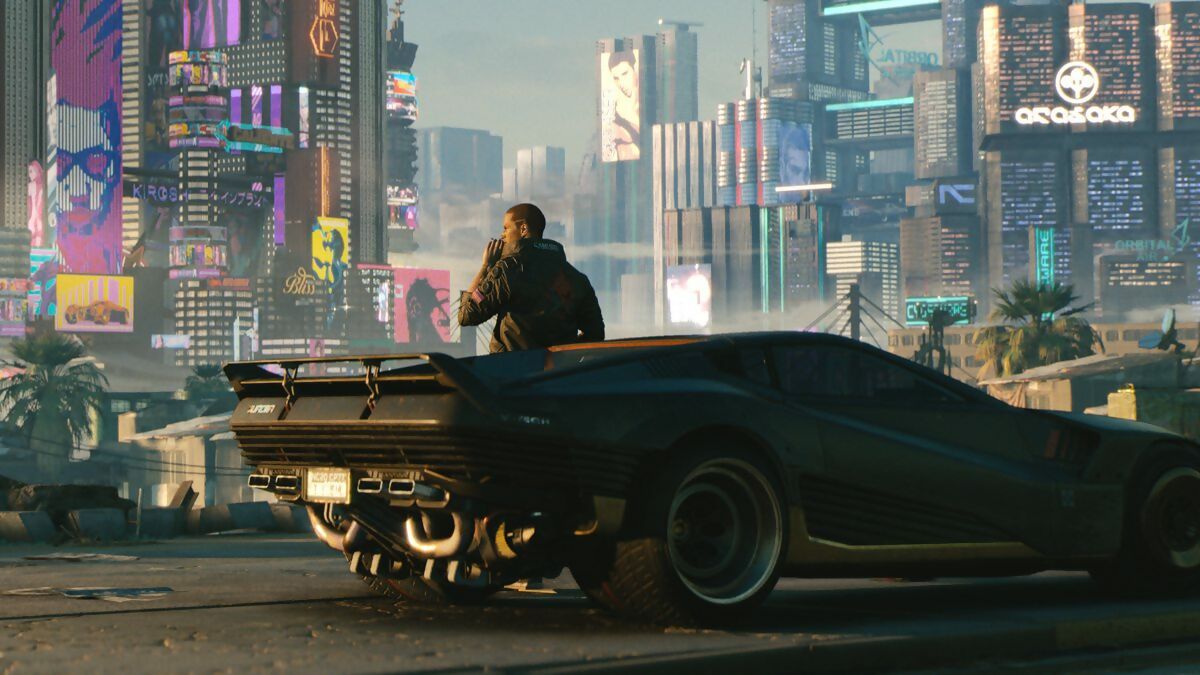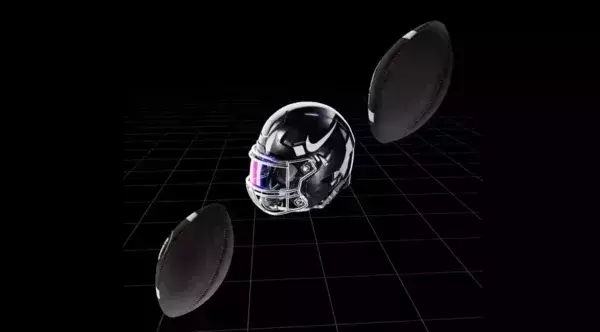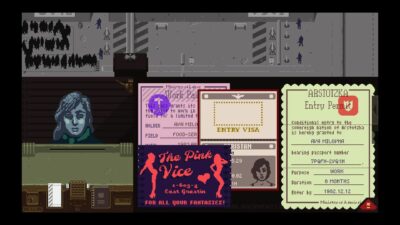
In the grime and murk of Night City, gaudy adverts blare and shady characters bustle back and forth on the crowded pavements. It’s the world of CD Projekt Red’s forthcoming Cyberpunk 2077 – a world so detailed it’s easy to forget that it’s based on a tabletop role-playing game first published in the 1980s.
A world that once existed in the pages of a rule book or the minds of its players is being realised in a fully-3D form that, at least judging by the hands-off glimpses offered by CD Projekt in its reveal footage, is full of detail and systems that react to the player’s actions.
And yet, beneath the 21st century sheen of Cyberpunk 2077’s voice-acted characters and high-resolution textures, traces of its pen-and-paper legacy still remain. At its heart we find the character creation, evolving skill sets and intricate world-building that has made designer Mike Pondsmith’s original tabletop RPG, Cyberpunk 2020, so enduringly popular.
If those elements are easy to miss among the blinking neon signs and screaming gun battles of CD Projekt Red’s adaptation then, well, maybe that’s just proof that the elements that underpin most analogue RPGs are now so embedded in video games that they’ve become almost invisible. Games as fast-paced and violent as Dishonored and Devil May Cry still employ experience systems to add welcome depth to their fearsome action; Borderlands contains random weapon drops and skill trees.
All the same, the process of adapting tabletop RPGs to the video game medium remains a difficult one. So what, exactly, are the pitfalls of adapting an analogue RPG to a computer or console? How are the two similar, and in what ways do they differ? To find out, let’s briefly
head back to the 1970s, when both the video game medium and the tabletop RPG were still in their infancy.
THE DIE IS CAST
Just about anyone who’s ever thrown a twelve-sided die will know something about the tabletop RPG’s formative years. Although many of its rules and elements hark back to tabletop war-games, it was Dungeons & Dragons, designed by Gary Gygax and Dave Arneson, that established the framework of the pen-and-paper RPG. First published in 1974, Dungeons & Dragons introduced a complex set of rules which allowed a group of players to create and inhabit imaginary characters and embark on fantastical quests.
D&D’s mechanics are underpinned by numbers and probability, whether it’s a character’s intelligence and ability to wield a sword, or how much damage they take when they’re smitten by an enemy’s club. But what really makes D&D so absorbing to its devoted core of fans is its concept of a shared storytelling experience.
Although playing D&D requires physical items like dice and a pen and paper, its true magic is that its stories are sculpted by the decisions of both the player and the Dungeon Master (or Game Master) who presides over its imaginary world. The Game Master can follow the rules as rigidly or as loosely as he or she likes; they can intuit when players are growing frustrated or bored by a difficult encounter and modify the game accordingly. By the same token, players can make unpredictable decisions that a Game Master could never foresee.

First published in 1988, Cyberpunk (later Cyberpunk 2020) established a high-tech dystopia of body mods and gloomy social malaise.
Even the most cutting-edge of modern RPG video games can’t quiet replicate the sheer freedom of a pen-and-paper adventure, as Fallout 2 designer Chris Avellone points out.
“With tabletop games, the Game Master can react to player actions on the fly, and customise and refocus the adventure quickly, while in a computer role-playing game you have a finite set of actions and results the players can engage in,” Avellone says. “And you have to plan for them all in advance of the game’s release, and ensure you’re giving enough options to the player to make the ‘role’ in ‘role-playing game’ worthwhile.”
Tabletop campaigns can last for hours, days, or even years; players are able to inhabit their characters for so long that they can take on an imaginary life of their own. Indeed, tabletop RPGs are only really limited by time and imagination; video games, meanwhile, are made with one eye on costs. One developer who knows all about this is Mike West: he’s the creative director behind the upcoming RPG Gloomhaven, adapted from the tabletop game of the same name, so he’s well aware of how a budget can inform the scale and detail of a role-playing video game.
“Game development costs money,” West says. “Every wall, crate, door, or chest, every monster animation, spell effect, or weapon mesh, every line of dialogue, dying scream, or dragon roar, and every choice made and the consequences from those choices needs to be budgeted and paid for. When you face a dragon in a pen-and-paper RPG, it’s words, with some numbers on a sheet of paper, or maybe a lead miniature. In a video game, it’s cold hard cash.”
PAPER TO PIXELS
As the popularity of the tabletop RPG grew through the second half of the 1970s, so too, of course, did the new medium of video games. And while early computer and console games like Pong, Breakout, and Space Invaders often focused on action, game designers were also quick to figure out how the rules and storytelling of tabletop RPGs could be adapted to a machine.
As early as 1975, Dungeon, programmed by Dan Daglow on a PDP-10 mainframe computer, attempted to simulate the combat and high-fantasy setting of Dungeons & Dragons in just a few lines of code. In 1979, Richard Garriott (better known as Lord British) created Akalabeth: World of Doom for the Apple II – a fantasy RPG that served as a dry-run for his genre-defining Ultima series. The late seventies also saw the growth of the MUD, or Multi-User Dungeon – a pioneering ancestor of the modern MMORPG.
Although these early games couldn’t hope to recreate the social nuance of the D&D campaigns which inspired them, they still managed to zero in on the two other pillars of the tabletop RPG: a system of rules governed by mathematics, and the creation of an imaginary world that is affected in some way by the player’s choices. From 1975’s Dungeon to 2015’s The Witcher 3, it’s these pillars of systems and storytelling that video games have sought to evolve and improve on ever since.
“D&D and other pen-and-paper RPGs are still the ultimate goal for video game RPGs,” concurs Mike West. “These P&P games allow players complete freedom in their choices, the characters they play and the locales and situations they find themselves in, while video games are continually evolving to replicate this. More and more of these elements will find their ways into the video games you play, although we are still a long way off from free-form video game role-playing.”
Chris Avellone adds: “A lot of the principles D&D established – statistics for characters (Strength, Intelligence, Class Levels, Hit Points), RPG races and classes, and even the creatures you encounter – still find their way into video games today.”

Baldur’s Gate was such a classic because BioWare “genuinely cared about translating it properly,” according to Chris Avellone.
ADAPTATION
Through the eighties and nineties, video game developers took a varied range of approaches when adapting the rules of tabletop RPGs. Indeed, entire subgenres have sprung up around those differing approaches; there are hack-and-slash games – like John Palevich’s seminal dungeon crawler, Dandy – that take some elements from tabletop RPGs but eschew much of their depth and nuance. A mechanically complex game like Baldur’s Gate, meanwhile, adheres quite closely to the rules of Advanced Dungeons & Dragons’ 2nd edition, such as the creation of characters defined by their race, class, and abilities. (“The Baldur’s Gate series did a great job,” says designer Chris Avellone, “mostly because I feel BioWare genuinely cared about the licence and genuinely cared about translating it properly.”)
You only have to look at the staggering variety of games adapted from Dungeons & Dragons to see how many different ways a tabletop RPG can be reinterpreted as a video game: from the ambitious Pool of Radiance, SSI’s RPG from 1988, to the more action-oriented console title Forgotten Realms: Demon Stone from 2004, developers have picked and chosen elements from tabletop RPGs to suit their own adaptations. It’s inevitable, too, that some of these adaptations have been better than others. As CD Projekt Red’s Marcin Blacha – story director on Cyberpunk 2077 – tells us, there are a number of pitfalls a developer can fall into when adapting a tabletop RPG.
“The main pitfall of adapting a tabletop RPG into another format is the belief that a set of rules and the setting is enough to recreate the fun of playing with friends,” Blacha says. “Single-player video games, however, are meant to deliver a different kind of experience. The dynamics are focused on the interactions between the player and the game, the latter replacing other participants of the experience. We can’t script human complexity, wit, and imagination. We can, however, create an elaborate and believable sandbox, featuring a focused direction, vivid visuals and sound, and meticulously crafted dialogues. In my opinion, a good tabletop adaptation should take what’s important in the source material, that which makes it unique, and build a convincing and directed experience based on it.”
It’s deciding exactly how to implement the mechanics of a pen-and-paper RPG in a video game that provides developers with the biggest challenge, in Chris Avellone’s experience; whether it’s how spells and abilities work, or how turn-based combat is translated to a real-time system, there are dozens of creative decisions to be made at every stage.
“In a computer game with very finite results and outcomes, you need to redefine exactly what that wide-ranging spell can do in the context of the game,” Avellone says. “Furthermore, you’ll discover that many spells meant to aid travel and exploration may not directly translate into a computer game, because they need the fictional game environment a Game Master can narrate.”
“The first thing you have to decide is what must go in,” says Gloomhaven creative director Mike West. “The core of the game, the rule-set, the setting, certain creature types or hero classes… Once you have all of that, you have your MVP, or Minimum Viable Product. It sounds quite businessy, but fundamentally, you’ve listed everything that a fan of the game will expect. You then see how much that costs; if it’s in budget, you then add other features until it fills the budget up.”

Based on the tabletop RPG, Gloomhaven is currently in development at Flaming Fowl Studios.
Indeed, adapting the rules of a tabletop RPG can be tricky to replicate in a video game, not just because of their complexity but because of their potential flexibility. Chris Taylor, lead designer on the original Fallout and inventor of the SPECIAL system (which directly emulated ability sheets of tabletop RPGs), reminds us rule zero in the original Advanced Dungeons & Dragons books read: “This game is unlike chess in that the rules are not cut and dried.”
“Rule zero is the most important rule in tabletop RPGs, and computers don’t like ‘guidelines,’” Taylor says. “They like hard, cold, well-defined mathematical equations.”
Even a tabletop war-game, with a more rigid set of rules than a typical bout of Dungeons & Dragons, can pose challenges of their own as they’re adapted into a video game. Taylor experienced this for himself in the late 1990s, when he worked on Star Trek: Starfleet Command – an adaptation of the Star Fleet Battles tabletop war-game.
“Even with all those well-written rules,” Taylor says, “we had to make some changes to fit the computer game. One consideration is that we were going from a turn-based game to real-time. We also removed or automated some of the player decisions to streamline the user interface.”
Then again, some systems can translate quite cleanly from one form of game to the other: turn-based combat, for example, can work extremely well in a video game if it’s balanced correctly.
“All the mechanics of combat and strategy translate very well,” Mike West says. “For example, Gloomhaven is primarily a combat-oriented strategy board game with an RPG choice-and-consequence wrapper. Combat between animated characters, with magical spells flying around, the roars of enemies and clashing of weapons, is always going to do a better job of portraying what is happening than rolling dice and moving lead figures around on your dining table.”

The forthcoming Disco Elysium uses extensive dialogue trees to illustrate everything from inner thoughts to combat choices.
DIFFERING DYSTOPIAS
As an example of how the mechanics of a tabletop game can be interpreted in wildly different ways, it’s worth comparing Cyberpunk 2077 with a much lower-budget game: Disco Elysium. The latter, developed by Zaum Studio, actually began life over a decade ago as a pen-and-paper game. Its lead writer and designer, self-confessed Dungeons & Dragons fan Robert Kurvitz, began work on the game in its nascent form over 15 years ago.
Brought to life with distinctive, hand-painted graphics, Disco Elysium takes a distinctly literary approach to its storytelling that will be immediately familiar to players of tabletop RPGs. The detective’s path through the game is governed by his inner dialogue, and the player’s choices define both how the anti-hero reacts to the world and, in turn, how its inhabitants react to him.
In Disco Elysium, even combat is derived from inner dialogue options rather than selecting predefined moves like ‘punch’ or ‘shoot’. There are turns (here dubbed whirls), there are dice rolls that decide outcomes, but the results of those outcomes are varied and unpredictable: a player’s choice during any given moment can determine with characters are killed, injured, or get away unscathed.
“If this sounds like a lot to produce,” Kurvitz writes on the game’s dev blog, “then that’s because it is. Do not expect an encounter to await behind every corner. But I thoroughly believe this approach is, if not the future of RPGs, then an early warning of that future.”
Cyberpunk 2077, on the other hand, takes a more aggressive, real-time approach to its combat. While its developers say the game’s an RPG first and an FPS second, its level of action will certainly help endear it to an audience unfamiliar with its tabletop origins. Not that its pen-and-paper underpinnings are difficult to spot: for CD Projekt Red, capturing the essence of Pondsmith’s original game – if not all the mechanics – was key.
“We had numerous discussions on the subject of which Cyberpunk 2020 features we wanted to include in our game,” Marcin Blacha tells us; “from the mechanics, to the general look and feel of the world and its individual building blocks, to the iconic characters. Mike Pondsmith is, of course, an important person in that conversation. We exchange ideas, consult with him regarding matters related to the game’s setting. As the creator of Cyberpunk 2020, he knows the universe we’re working within inside out, which makes him an invaluable member of the team.”
INTO THE FUTURE
Video games and tabletop RPGs, then, are two separate nations united by a common language: at their best, they both use complex mathematical systems and intelligent storytelling to create imaginary worlds and characters that, in the moment, feel astonishingly real. At their heart, tabletop RPGs are essentially a form of co-authored storytelling, where the level of freedom to improvise and explore is limited only by the participants’ time and imagination. Mike West also points out that tabletop RPGs have another useful side effect: they can teach players a great deal about the mechanics of making games.
“Anyone who’s sat down and run their own RPG campaign with their friends likely has a good understanding of storytelling, branching narrative, combat mechanics, and gameplay balance,” West says. “All of these skills are highly desirable for modern-day game developers.”
Video game RPGs, meanwhile, have evolved to an astonishing extent since the medium began; games like EverQuest and Neverwinter Nights make an impressive attempt at simulating the experience of being a Game Master; Planescape: Torment and Disco Elysium feature vast dialogue trees; the Elder Scrolls games depict huge worlds and ever more realistic illusions of non-player characters with their own personalities, histories, and goals.
It follows, then, that RPGs will continue to evolve in exciting and unpredictable ways – even as they continue to draw on the influence of those tabletop RPGs that originally set the pace.
“The main way RPGs will evolve,” West says, “is by being able to generate better and better content on the fly without having to be authored by designers like me. Computers will soon be able to make quest structures, give characters long term motivations and make any interlocking stories that the player can get involved in. These stories will also allow many more emergent consequences than you see now.”
“One path could be more reactive storytelling,” Chris Taylor agrees. “More depth, more options for the player, larger dialogue and story branches. Of course, that’s more content, which would require more development money. Since big-budget games have more concerns about risk, I expect most evolution will come from smaller titles. Perhaps AI research will advance to a point where we can have virtual GMs that create or modify content on the fly. I look forward to playing those in my self-driving flying car.”

Sales disappointment, now a cult classic: 1993’s Shadowrun on the SNES
CASTING SHADOWS
Inevitably, the process of adaptation can be a painful one. The making of Shadowrun, a take on FASA’s 1989 tabletop RPG of the same name, for example, was infamously difficult. Australia’s Beam Software first began work on its adaptation for the Super Nintendo in 1989, and the team sought to retain much of the source game’s mechanical complexity. Shadowrun took a then-hefty four years to make, and was a financial disappointment when it finally emerged in 1993. The game quickly garnered a cult following, however, and has since been praised as a pioneering instance of a console RPG made with depth as well as style; indeed, it could be argued that Shadowrun was an early foray into territory later explored by the likes of an acclaimed series like Mass Effect.
VIDEO GAME TO TABLETOP?
The adaptation of tabletop RPGs to video games isn’t necessarily a one-way street. In the 2000s, Chris Avellone was designing Black Isle Studios’ sequel to Fallout 2, code-named Van Buren. For the most part, Avellone was the only developer working on the project, and so he came up with a cunning way of testing its systems out by himself: “I turned Van Buren into a pen-and-paper game that I and the devs who’d eventually move onto the project could play,” Avellone explains. “They could develop characters, explore areas I’d laid out, test certain companions for the game, and see what worked and what didn’t.”
Avellone says he quickly gained useful feedback from this analogue playtesting method. And while Van Buren was later cancelled, Avellone believes it’s a great way of finding out whether a game’s systems will work for players. “I wish more titles had the chance to get such direct, immersive feedback from developers and players ‘adventuring’ through the computer game version on paper,” he says.
THE DIGITAL ADVANTAGE
Video game RPGs have one obvious advantage over their tabletop counterparts, Chris Avellone points out: you can play them on your own.
“When I was growing up, I wanted to play tabletop games, but trying to gather a group and also trying to find someone willing to put in the work to be a Game Master was difficult,” Avellone tells us. “But the first time I saw The Bard’s Tale II being played on my friend’s Commodore 64, I suddenly realised, maybe I didn’t have to wait for someone willing to take up the reins. I could play against a digital Game Master and still have an enjoyable experience.”





